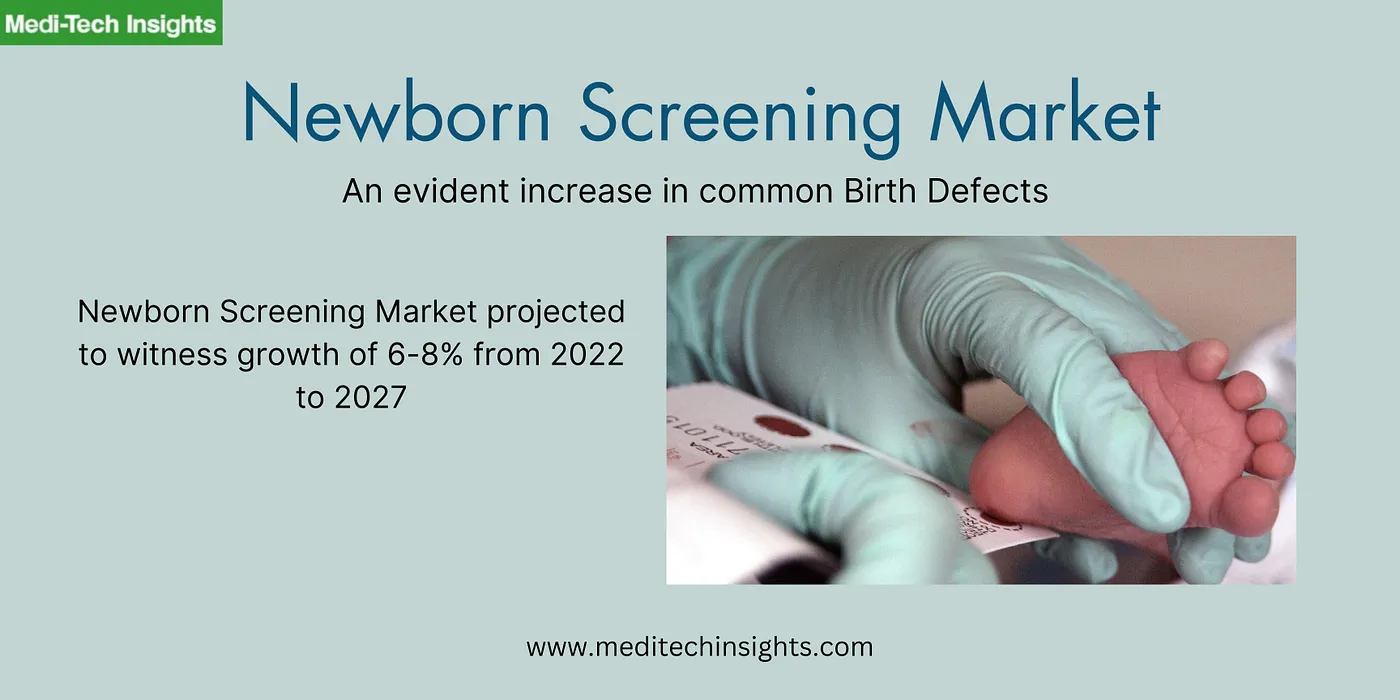Global Newborn Screening Market is projected to grow at a CAGR of ~6–8% from 2022 to 2027. This is likely to be driven by an apparent rise in common birth defects, growing lab efficiency, growing populations, and increasing incomes/affluence in SEA and other developing economies.
Newborn screening aims to detect infants at risk of genetic, hormonal and metabolic conditions. These screenings are used to confirm a diagnosis and enable for early intervention in the hope of the prevention or amelioration of the disease. These tests are most commonly performed for conditions that are not clinically evident in the neonatal period but are likely to be treatable with early intervention.
Commonly covered conditions include congenital hypothyroidism (CH), Phenylketonuria (PKU), congenital adrenal hyperplasia (CAH), cystic fibrosis (CF), galactosemia (GAL), tyrosinemia type I (HT1), sickle cell anaemia, G6PD-Deficiency, hearing problems (congenital deafness) and congenital heart problems. These are tested through three standard methods: Blood spot, hearing test and pulse oximetry.
To know more about the research report, fill out a quick inquiry for a sample report: https://meditechinsights.com/newborn-screening-market/request-sample/
Growing Population, Rising levels of birth defects, and favourable government initiatives are some of the major drivers for the growth of the newborn screening market
The global population projected to grow to 9.7 billion people by 2050 from 8 billion in 2022 and improving access to primary care (evidenced by significant global improvements in life expectancy from 46.5 in 1950 to 71 in 2021) are major driving factors in the growth of the newborn screening market.
Worldwide, an estimated 8 million newborns are born with a birth defect every year. As per CDC, birth defects affect one in every 33 babies (about 3% of all babies) born in the United States each year. In the WHO South-East Asia Region, between 2010 and 2019, birth defects increased as a proportion of child mortality in the region, from 6.2% to 9.2%. Heart problems, neural tube defects, and Down syndrome are among the most frequent serious birth disorders. These can be caused by one or more genetic, infectious, nutritional or environmental factors. To curb the rising birth defects, health organizations across the globe are taking necessary actions to prevent, detect, manage and care for birth defects.
Developing countries are increasingly investing in the provision of newborn screening. For instance,
· Brazil passed a law in 2021 mandating that all states must implement an expanded NBS programme by June 2022 — these targets have fallen short in some states however the programme continues to progressively expand to include lysosomal diseases, immunodeficiencies, and spinal muscular atrophy
· Furthermore, Columbia, Chile & Panama are in the process of expanding their testing coverage from 70–80% to >90% of newborns as well as expanding the number of conditions screened for

The growing use of next-generation sequencing (NGS) in developed nations is expected to fuel the newborn screening markets
NGS approaches are steadily being embraced in hospital settings for use in newborn screening for rare genetic disorders. The cost of sequencing whole exomes has fallen dramatically since its invention and continues to decrease — in the US, bioinformatics companies can provide sequencing for ~$500-$900. Pilot studies are being conducted in the US, UK, China and several other countries into the suitability for the widespread use of NGS technology in newborn screening programmes as well as in neonatal wards.
Organic and Inorganic Growth Strategies Adopted by Players to Establish Their Foothold in the Newborn Screening Market
Most commonly conducted tests are widely recognized and accepted. Companies primarily focus on expanding their production capabilities or participating in mergers and acquisitions to enhance their market standing or divest non-essential assets:
· In August 2022, Perkin Elmer sold off its Applied, Food and Enterprise Services businesses, and entered into a definitive agreement with New Mountain Capital, L.L.C. to sell off its assets for a total compensation of $2.45 Bn
· In August 2022, Triviton Healthcare opened a new R&D and manufacturing facility for chemical-based assays in India. The new center will have provisions to manufacture >300 million RT-PCR kits and >100 million for ELISA, CLIA, NBS and other common diagnostic kits
China is expected to hold the largest share of the Newborn Screening market — followed by North America
While China is the Biggest market — 9.56 million babies were born in China in 2022, down from 17.86 million in 2016. Approximately 93% of newborns are reported to undergo screening in China — the availability of the range of tests available varies between urban and rural regions. The penetration of newborn screening in China is poised to grow in the future years due to government initiatives, growing number of newborn screening centers and establishment of well-developed newborn screening network system. The Chinese government recognizes newborn screening as a public health project and by the end of 2018, there were ~238 newborn screening centers in the China mainland with screening rates exceeding 97.5%. China newborn screening has Developed and Implemented a complete network system, from sample collection and delivery, laboratory testing, results reporting, clinical diagnosis to follow-up which has also played a pivotal role in its penetration. Meanwhile, India has become the most populous country on earth — ~23 million babies were born in 2022 however currently there is no active national NBS programme in India.
The Price of performing standardised tests is reducing steadily, increasing the feasibility of performing population-wide screening exercises in developing nations. Programmes already exist for the majority of developing nations and the cost-effectiveness of these campaigns due to increasing efficiency in lab operations, increased IVD manufacturing capacity post-COVID and economies of scale make them highly attractive to governments.
Competitive landscape of the Newborn screening Market
The market is marked by the presence of key players such as SCIEX, Agilent Technologies Inc., Bio-Rad Laboratories Inc., Covidien Plc, GE Healthcare, PerkinElmer, Inc., Masimo Corporation, Natus Medical Incorporated, Trivitron Healthcare, Waters Corporation, Labsystems Diagnostics Oy, LifeCell International Pvt.Ltd, Archer DX and others.
Get Detailed Insights on the Newborn screening Market @ https://meditechinsights.com/newborn-screening-market/



